In recent years, there have been significant changes in the way networks are built, managed, and run. Many IT admins are now replacing legacy networking components and traditional techniques with much more advanced networking concepts and strategies. For instance, they are increasingly relying on concepts such as network containerization, automation, software-defined networking (SDN), and cloud computing to simplify networking.
These technology changes and deployments have been accelerated by organizations needing to enable a business-driven, application-focused networking experience that ensures a high quality of service.
One new technology that is gaining traction in the network management community is the software-defined wide area network (SD-WAN): the new, improved, next-gen wide area network (WAN). But how does it simplify networking, and what benefits does it offer over existing traditional networks?
Let us dive in to,
As a part of the SDN management concept, an SD-WAN enables its users to configure and tune their networks with the aid of software.
In any typical IT infrastructure, there are two primary types of networking deployed: a local area network (LAN) and a WAN. While the LAN enables network connectivity for devices within an office or campus, the WAN enables network connectivity between different offices or remote sites. This requires the WAN's edge devices to constantly employ routing techniques to route data to the required destination.
An SD-WAN offers a more efficient, smarter alternative. It centralizes the control mechanism by decoupling it from the different edge devices in remote locations. With routing decisions now configurable, the SD-WAN offers a programmable, cost-effective approach to enabling network communication by using the different data transport options available. This way, the network traffic is managed more dynamically and efficiently since it is no longer limited by stringent manual configuration requirements and complex routing protocols. This results in increased network reliability, agility, performance, and connectivity; simplified scalability; and reduced operational costs.
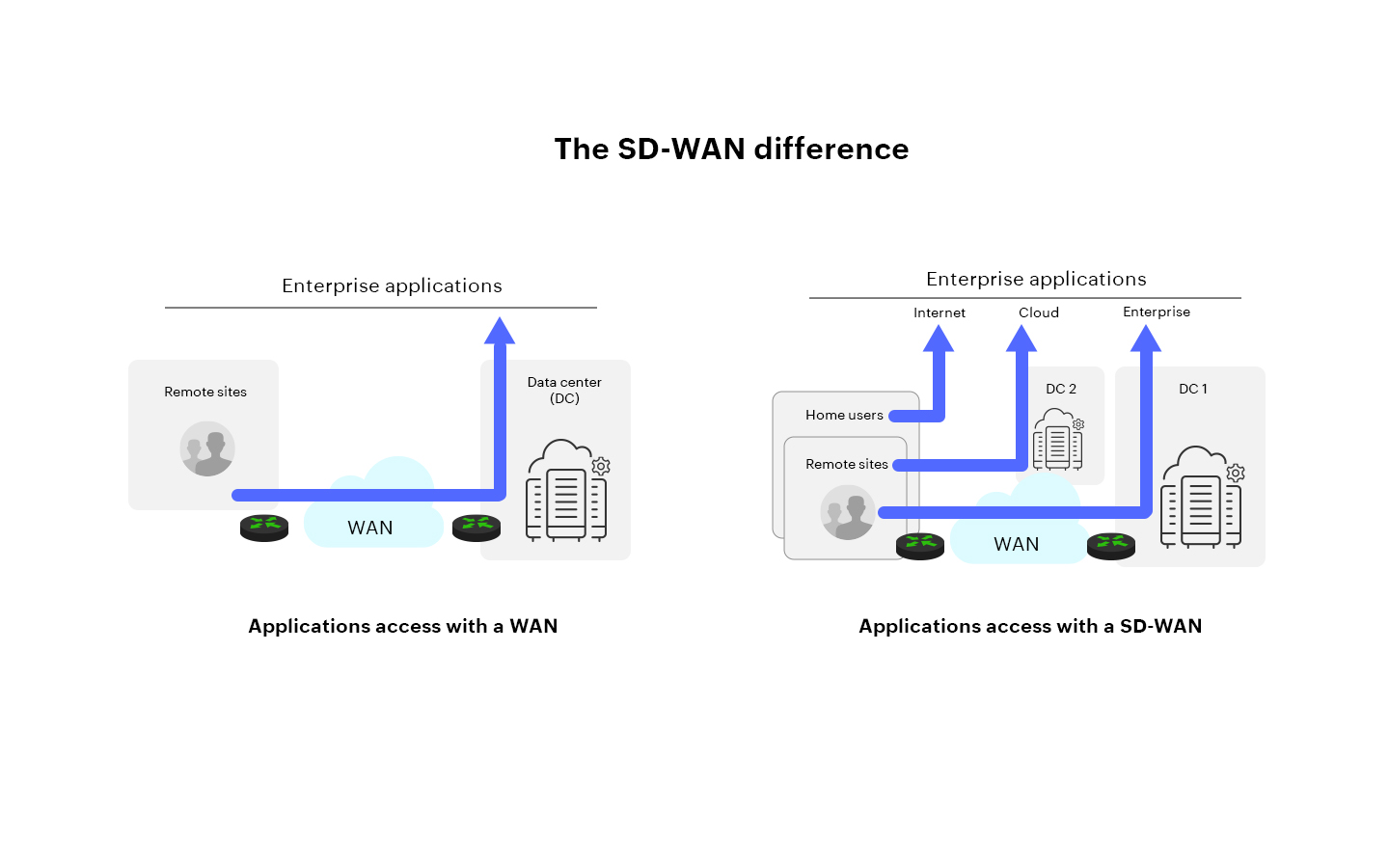
For more than a couple of decades, we have been relying on WAN connections to enable connectivity between our remote offices. So why should we consider the SD-WAN now? Will it actually outperform the benefits of our existing WANs, or is it just another technology labeled software-defined? To answer this, it is important that we contrast the architecture, capabilities, and benefits of SD-WANs with those of our traditional WANs.
Let us assume that your organization has its HQ in California and that it is connected to four other remote sites: A, B, C, and D.
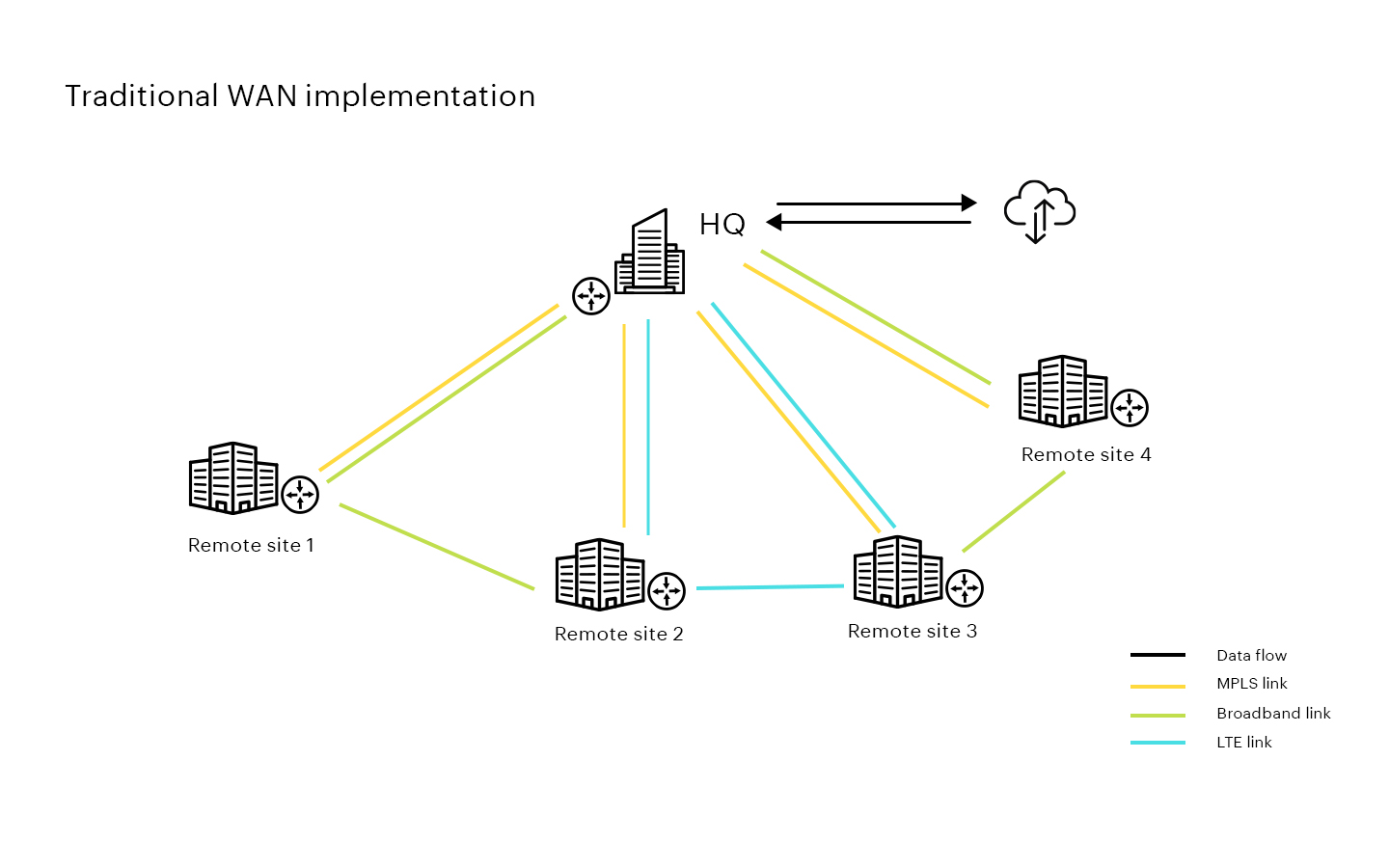
As a network admin, you need to enable and maintain connectivity between your HQ and the different remote sites. You choose to enable this connectivity using WAN technology. This means that you will rely on routers, MPLS, and other data transfer components for network communication.
To ensure complete connectivity, let us assume that you choose to set up a full mesh network between the network nodes (N) (i.e., the different remote sites and HQ). Technically, this would require N(N-1)/2 network links. So, for network connectivity between your HQ and the four remote locations, you need to set up 5(5-1)/2 = 10 MPLS connections. However, while these 10 MPLS connections can ensure effective networking, they can be expensive and strain your network management budget.
That is not the only drawback of traditional WANs. Edge networking devices, such as routers, are tedious to configure since they mostly operate on CLIs. Thus, to set up each router, you need to reach the location physically and configure the rules on how to handle network traffic.
For instance, let us assume that each of the four routers in your remote locations requires 15 seconds to execute each of the 10 CLI commands necessary to load a configuration script. This means that you have to not only execute 40 CLI commands (10 commands ⨯ 4 remote sites) but also spend 10 minutes doing so (15 seconds ⨯ 40 commands) every time you have to make a small script change. While this might sound like a small amount of time, imagine this on a scale of 10 or even 100 remote sites.
As demonstrated above, deploying and managing traditional WANs is not just expensive but also cumbersome, demanding a significant amount of manual work and time. WANs also pose the following drawbacks that prevent effective networking:
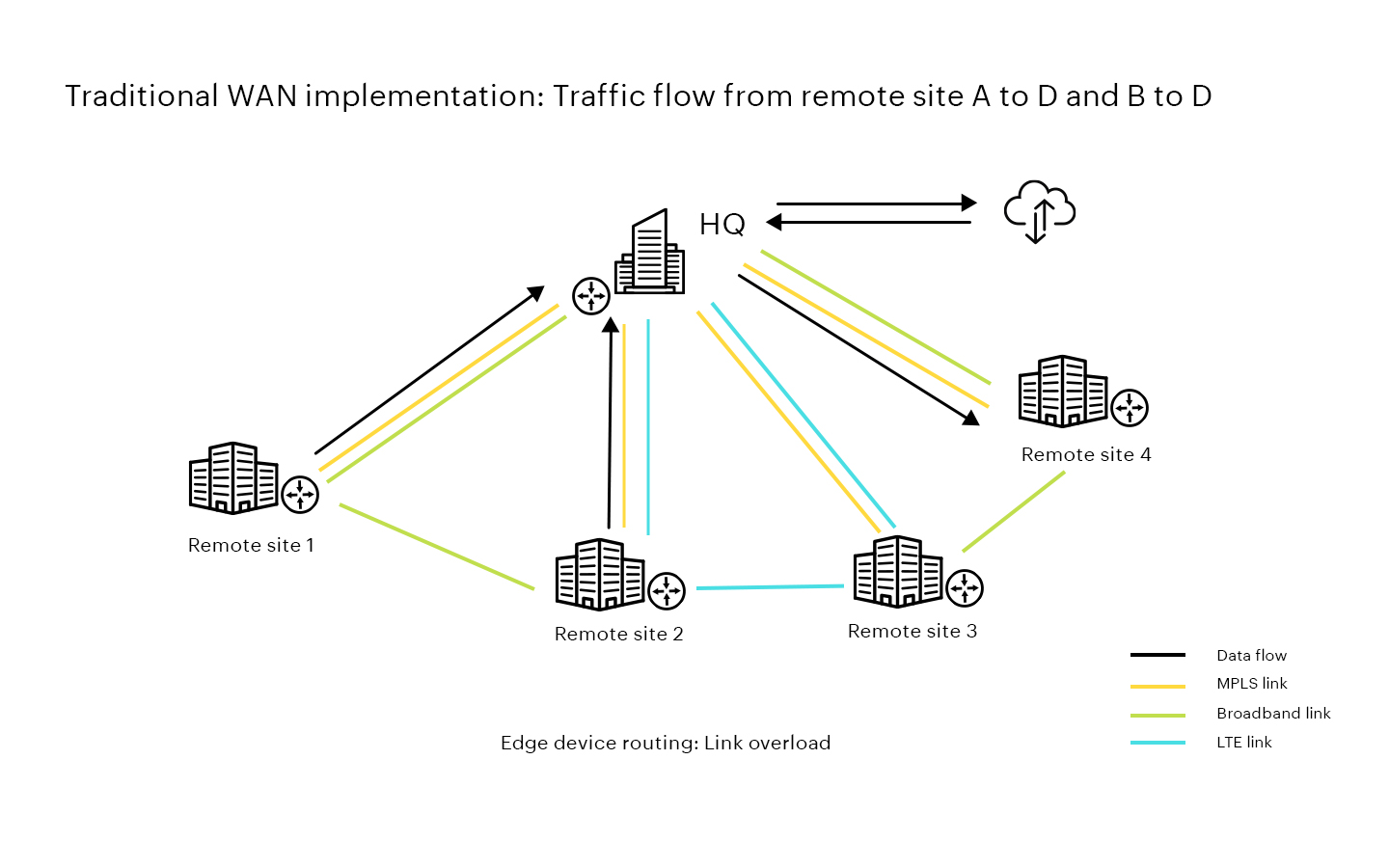
Let us consider the same network we discussed above. In this network, both the data plane and the control plane have been running on the edge devices (routers). SD-WAN technology redefines this process by virtually taking over the control plane from all the edge devices and centralizing them in its console.
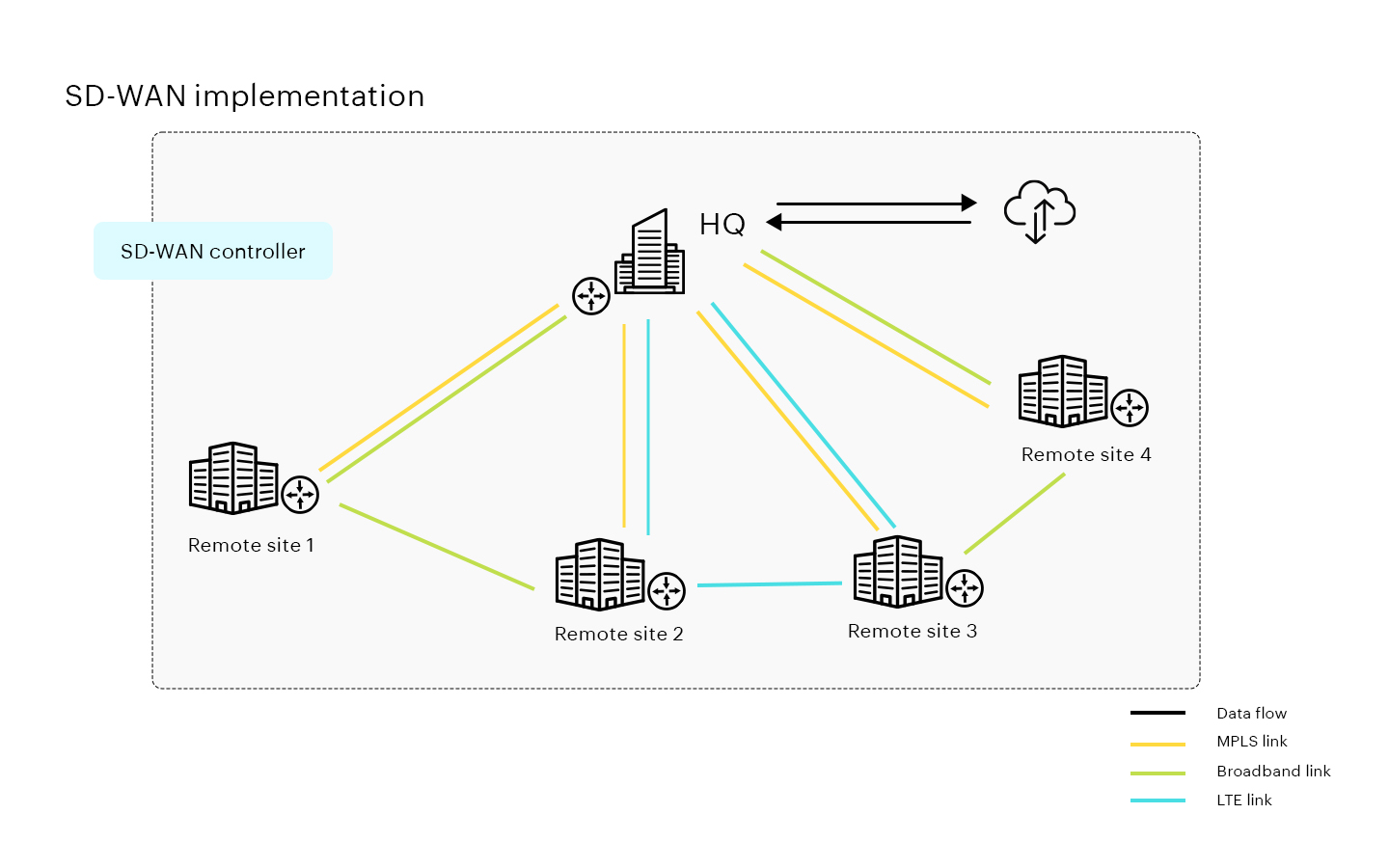
An SD-WAN ensures there is an effective routing strategy in place with its dynamic link shifting capability. It enables you to use different data transport channels, such as MPLS and broadband communications, to enable network connectivity. This also effectively increases the failover capability of your network.
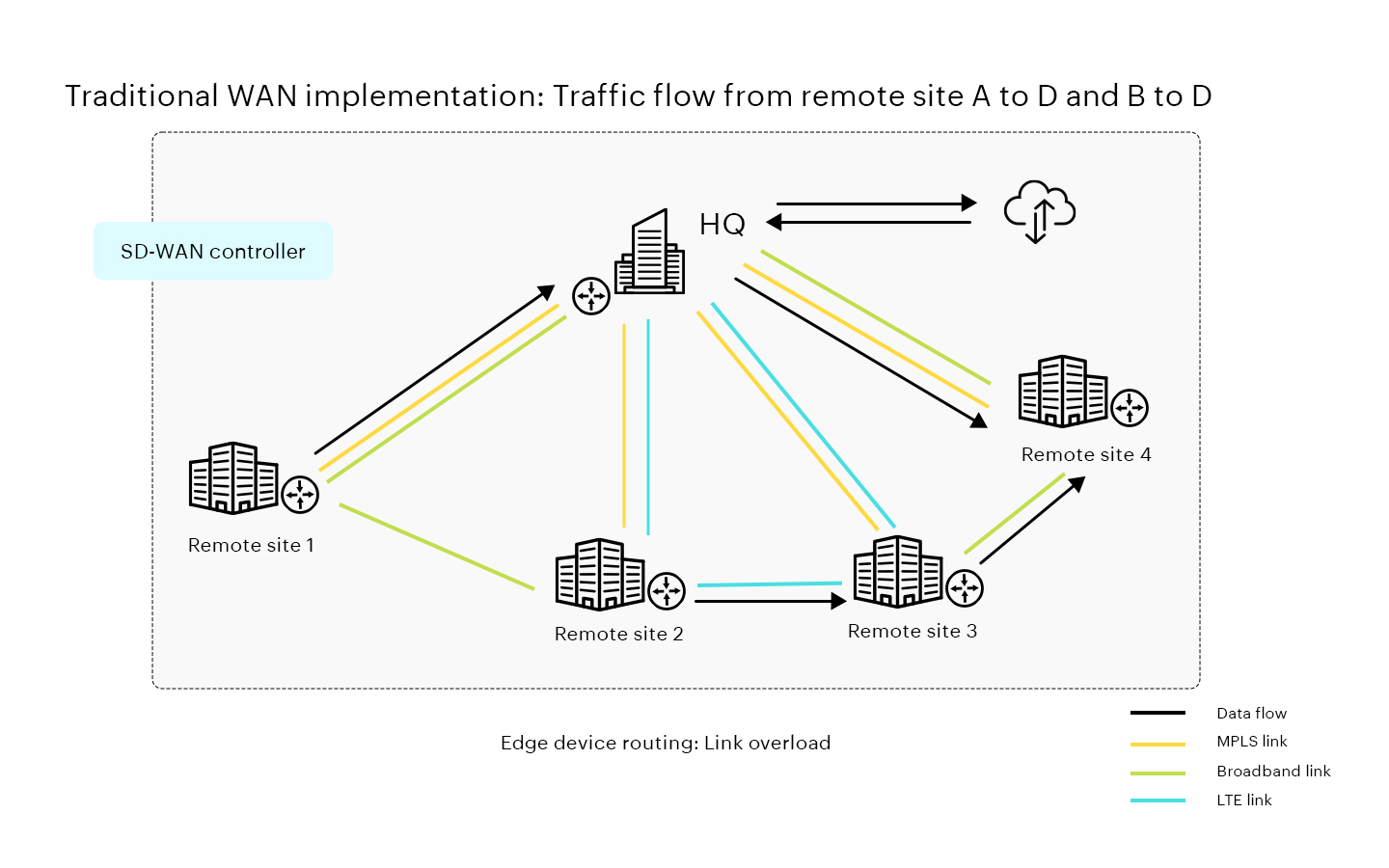
Optimal routing: In contrast to traditional WAN connections, an SD-WAN does not operate based on the shortest path routing mechanism. It evaluates all the available paths and chooses the best path to route the network data. This way, if your primary link is already running priority traffic, you can use your second-best link to route your network traffic.
Load sharing: SD-WANs ensure that the traffic load is optimally shared among different data transport links. This helps you guarantee high quality service for your network's critical devices and end users.
Replacing expensive MPLS: An SD-WAN allows you to use different transport link types. This way, you can choose to use an expensive MPLS link only for the critical network traffic, thereby reducing the total number of required MPLS links.
Enhanced redundancy: With cost-effective dynamic routing, you can implement multiple network data transport links in your network.
With an SD-WAN, you need not spend a significant amount of time on tedious configurations every time a new edge device enters the network. Using several of an SD-WAN's software-defined templates and automation capabilities, you can easily plug and play your network's edge devices. This zero-touch provisioning of devices is made possible by an SD-WAN's automated device provisioning.
With traditional WANs, pushing any configuration or policy change requires time-consuming manual configurations. The administrator must also be physically present at every remote location to configure the edge devices.
However, with SD-WANs, any script, configuration, or policy change can be rolled out using its centralized console. The overlaying controller then implements these changes on the edge devices in the remote locations. This offers several benefits, such as reduced time and costs and improved network performance.
While SD-WANs were first implemented in the early 2000s, it was not until 2014 that this networking trend started gaining traction in the IT community. Increasing adoption of the technology is contributing to tremendous growth in the SD-WAN industry.
In a recent report on the SD-WAN market, Forrester stated the following:
The following are the SD-WAN industry leaders:
OpManager offers advanced network performance monitoring capabilities, including support for monitoring various SD-WAN devices, such as Meraki controllers. With built-in templates for easier discovery and monitoring, you can add different SD-WAN devices to be monitored with just a click.
With its alerts based on adaptive thresholds, OpManager ensures proactive monitoring and alerting. This helps you stay ahead of network issues and ensure constant network availability.
It also offers different mapping capabilities, including Business Views that help you visually set up the connections between your head office and remote sites. With its extensive set of reports, you can easily understand your networking requirements, thereby improving capacity planning.
Interested? Set up a free, personalized demo with our product experts or download a free, 30-day trial of OpManager today!